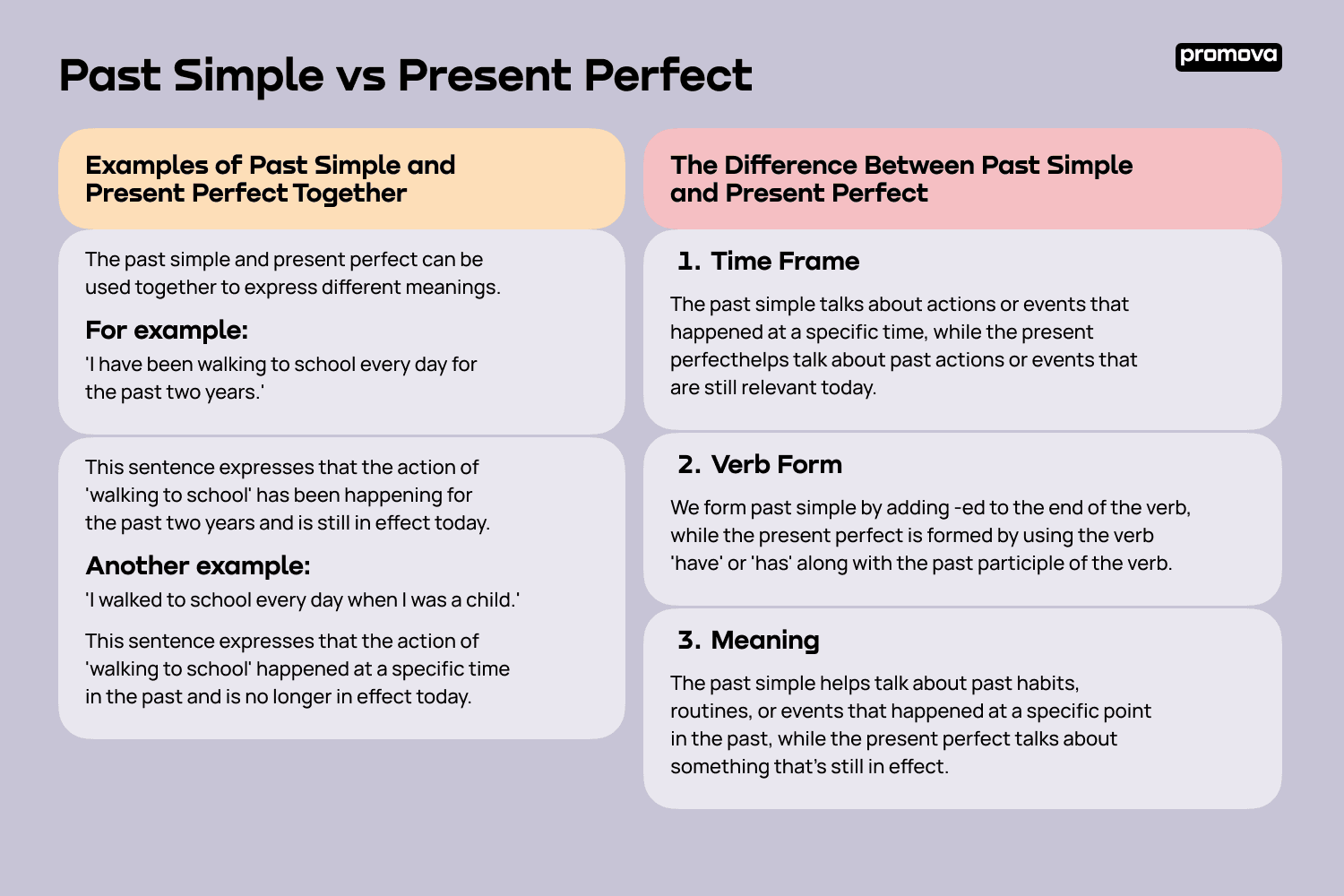Past Simple vs Present Perfect
Contents
When it comes to grammar, the difference between the past simple and present perfect can be tricky to grasp. In this reference, we will look at the past simple, present perfect, and the difference between the two. We will also look at how to form each tense, the uses of each tense, common mistakes to avoid, and some examples of the past simple and present perfect together.
What is the Past Simple?
The past simple is a form of the verb that expresses past actions or events. It is used to refer to a completed action or event that took place in the past. It is typically used to talk about past habits, routines, or events that happened at a specific time in the past. It is also used to give commands or instructions in the past.
We form past simple by adding -ed to the end of the verb. For example, the past simple of the verb 'walk' is 'walked'.
What is the Present Perfect?
The present perfect expresses actions or events that have happened in the past but are still relevant today. It is typically used to talk about past actions or events that have recently happened or that have had an effect on the present. It is also used to talk about past experiences or habits that are still in effect today.
We create present perfect with the verb 'have' or 'has' and follow it up with the past participle of the verb. For example, the present perfect of the verb 'walk' is 'have walked'.
How to Form the Past Simple and Present Perfect
When forming the past simple and present perfect, we form the past simple by adding -ed to the end of the verb, and the present perfect by using the verb 'have' or 'has' with the past participle of the verb.
For example, the past simple of the verb 'walk' is 'walked', and the present perfect of the verb 'walk' is 'have walked.'
In addition, when forming the past simple, remember that there are some irregular verbs that don't follow the normal -ed pattern. For example, the past simple of the verb 'see' is 'saw', and the past simple of the verb 'go' is 'went'.
When forming the present perfect, it is important to remember that there are some verbs that take the verb 'have' and some verbs that take the verb 'has.' For example, the present perfect of the verb 'walk' is 'have walked,' and the present perfect of the verb 'eat' is 'has eaten.'
4
Uses of the Past Simple
The past simple helps us talk about past actions or events that happened at a certain time in the past. It is typically used to express past habits, routines, or events.
For example, 'I walked to school every day when I was a child.'
The past simple is also used to give commands or instructions in the past. For example, 'My father told me to clean my room.'
The past simple is also used to talk about past experiences, such as 'I went to Paris last year.'
Uses of the Present Perfect
The present perfect is used to talk about past actions or events that have recently happened or that have had an effect on the present. It is typically used to express past experiences or habits that are still in effect today.
For example, 'I have been to Paris three times.'
The present perfect is also used to talk about past habits, routines, or events that are still in effect today. For example, 'I have been walking to school every day for the past two years.'
The present perfect is also used to talk about past events that have had an effect on the present. For example, 'My father has told me to clean my room.'
The Difference Between Past Simple and Present Perfect
- Time Frame. The past simple talks about actions or events that happened at a specific time, while the present perfecthelps talk about past actions or events that are still relevant today.
- Verb Form. We form past simple by adding -ed to the end of the verb, while the present perfect is formed by using the verb 'have' or 'has' along with the past participle of the verb.
- Meaning. The past simple helps talk about past habits, routines, or events that happened at a specific point in the past, while the present perfect talks about something that's still in effect.
Examples of Past Simple and Present Perfect Together
The past simple and present perfect can be used together to express different meanings. For example, 'I have been walking to school every day for the past two years.' This sentence expresses that the action of 'walking to school' has been happening for the past two years and is still in effect today.
Another example is 'I walked to school every day when I was a child.' This sentence expresses that the action of 'walking to school' happened at a specific time in the past and is no longer in effect today.

Summary
By understanding the difference between the past simple and present perfect, you will be able to improve your mastery of verb tenses. Remember that the past simple helps talk about actions or events that happened at a certain point in the past, while the present perfect helps talk about past actions or events that are still relevant today.
Other than that - take your time and practice both tenses to improve your skills!
Comments